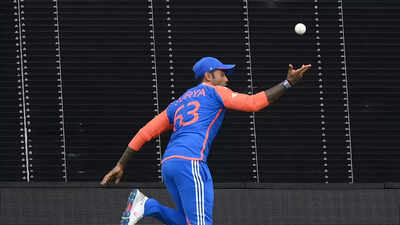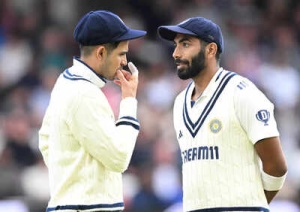The International Cricket Council (ICC) has unveiled a series of significant adjustments to the playing conditions across Test, ODI, and T20I cricket. These changes target key areas such as over rates, ball usage, boundary catches, concussion protocols, and the adjudication of wides.
 *Image credit: ICC*
*Image credit: ICC*
To combat slow over rates and minimize delays, the stop clock rule, previously trialled in white-ball cricket, is now a permanent fixture in Test matches. Fielding teams must commence a new over within 60 seconds of the completion of the previous one. Teams will be granted two warnings per innings. Subsequent breaches will result in a five-run penalty. The warning count resets every 80 overs, coinciding with the availability of a new ball.
In One Day Internationals (ODIs), the use of two balls will be restricted to the initial 34 overs. For the remaining 16 overs, the fielding side will have the option to select one of the two balls for continued use. This adjustment aims to better manage the wear and tear of the ball.
The boundary catch rule has been clarified. Fielders making airborne contact with the ball beyond the boundary must land completely within the field of play to complete a legal catch. Should a fielder step outside the boundary and jump again, they are permitted only one additional touch before landing inside the boundary.
The updated regulations mandate that teams pre-nominate concussion substitutes. Any player diagnosed with a concussion will be required to observe a mandatory seven-day rest period before being eligible to return to competitive play.
A new wide ball rule will be trialled in white-ball formats. The batter's position at the point of delivery—rather than after any movement—will serve as the reference for judging wides. Deliveries passing between the leg stump and the extended protected area marker at the popping crease will no longer be called wide. Deliveries passing behind the batter's legs may still be called wide. To aid umpires, the protected area marker will be extended to the popping crease.
The Decision Review System (DRS) will now utilize the actual physical outline of the stumps and bails to define the wicket zone, increasing accuracy in LBW decisions.
In addition to the existing five-run penalty for a deliberate short run, the fielding team will now have the right to choose which batter takes strike for the subsequent delivery.
Within domestic first-class cricket, a player who sustains a serious on-field injury at any point after the match has started (including during warm-ups) can be replaced by a like-for-like player for the duration of the game.
The new Test playing conditions came into effect on June 17, with the start of the Sri Lanka vs Bangladesh Test. The revised ODI and T20I rules will be implemented from the same series, starting with the first ODI on July 2 and the T20Is from July 10. All international matches scheduled beyond these dates will be governed by the updated regulations.
Newer articles
Older articles
 Evil Eye Amulet: Protective Charm or Portal to Dark Forces? A Cultural Debate
Evil Eye Amulet: Protective Charm or Portal to Dark Forces? A Cultural Debate
 Paralympic Archer Sheetal Devi's Viral Video Shows Her Driving Car with Feet, Defying Expectations
Paralympic Archer Sheetal Devi's Viral Video Shows Her Driving Car with Feet, Defying Expectations
 Umpire Controversy Erupts: West Indies Coach Sammy Questions Holdstock's Consistency in Barbados Test
Umpire Controversy Erupts: West Indies Coach Sammy Questions Holdstock's Consistency in Barbados Test
 Black Caps Set for Blockbuster Home Season Against Cricket Heavyweights
Black Caps Set for Blockbuster Home Season Against Cricket Heavyweights
 Batting Collapses and Dropped Catches Cost India Despite Pant's Centuries: Gambhir Defends Lower Order After Test Loss
Batting Collapses and Dropped Catches Cost India Despite Pant's Centuries: Gambhir Defends Lower Order After Test Loss
 Shastri Urges India to Reconsider Bumrah Rest Strategy After Headingley Defeat
Shastri Urges India to Reconsider Bumrah Rest Strategy After Headingley Defeat
 Suryakumar Yadav Sidelines: Indian Cricket Star Undergoes Surgery for Sports Hernia – What It Means
Suryakumar Yadav Sidelines: Indian Cricket Star Undergoes Surgery for Sports Hernia – What It Means
 20 Minutes to a Healthier You: Neurologist Reveals Simple Daily Habits to Combat High Cholesterol, Blood Pressure, and Dementia Risk
20 Minutes to a Healthier You: Neurologist Reveals Simple Daily Habits to Combat High Cholesterol, Blood Pressure, and Dementia Risk
 SA20 Teams Given Green Light for Six Player Retentions Ahead of Auction
SA20 Teams Given Green Light for Six Player Retentions Ahead of Auction
 Korean Diet Secrets: 5 Foods for Ageless Beauty and Radiant Skin
Korean Diet Secrets: 5 Foods for Ageless Beauty and Radiant Skin